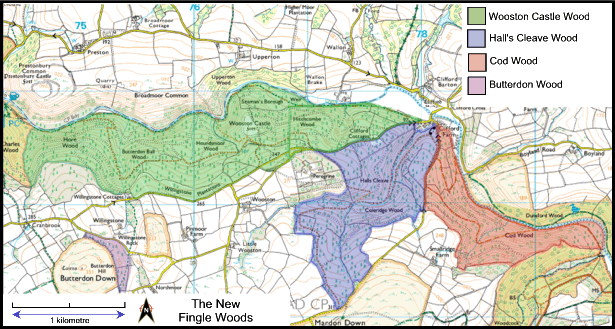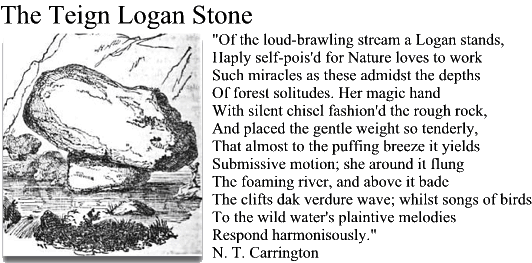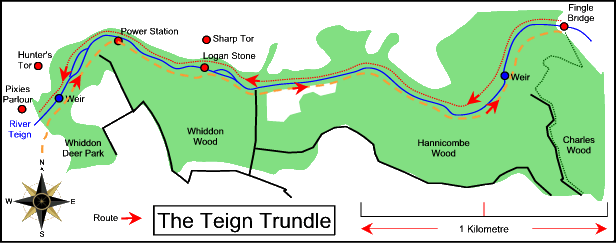
The Woodland Trust and National Trust were given the unique opportunity to purchase 340.47 hectares of woodland in an effort to restore them to ancient woodland. Fortunately by combining forces they managed to purchase the land before the final sale date thus ensuring the vision of their project. Much of this huge tract of woodland is at present off limits to the public and now it is intended to create some 48km (30 miles of footpaths) through these woodlands. Additionally the project would benefit the local fauna and flora some of which are becoming threaten species as well as securing a future for what plant and animal are already present. The main aim is to gradually over a fifty to seventy year period clear the existing conifer trees. This will change the present structure of the canopy to let in more light which will in turn give a chance for the re-establishment of ancient woodland species. It is estimated that the purchase of the land and help towards the progression of the project will cost in the region of £5 million. Consequently the Woodland Trust and the National Trust have launched an appeal to raise the funds. This actual tract of woodland lies between Castle Drogo and Steps Bridge and comprises of: Wooston Castle Wood (177.07 hectares), Hall’s Cleave Wood (95.61 hectares), Cod Wood (61.4 hectares) and last but not least Butterdon Wood (8.39 hectares).


The New Fingle Woods
I am not sure if it’s intended but to call the newly established woodland ‘Fingle Woods’ is a really good idea. The very name suggests something magical and is synonymous with the famous Fingal’s Cave on Staffa. Incidentally the word ‘Fingal‘ may derive from the medieval term ‘Fine Gall‘ which referred to a medieval territory and now a county in Ireland. Roughly translated it meant ‘tribe or territory of the foreigners’. Another interpretation found in suggest that the name derived from two elements; fyn meaning boundary and gelli meaning hazel, or possibly gill being a waterfall, Cromellin, p.64. Thus giving ‘boundary of or at the hazel or waterfall’? Other suggestions are the name of the small Fingle stream which name derives from the Old English stem word, fang which means to, ‘hold or catch’, Glover et all, p.432. This in their opinion could allude to a bountiful fish supply found in the stream. However, there are more alternatives, the Old English word Fengel means a ‘prince’ or ‘king’ or the alternative definition of the word Fang is – ‘plunder or bounty’. Another option is the word Fengelãd which means a ‘marsh path’ or ‘fen’, which when considering the stream could also fit.
Having read all about the appeal it reminded me that was many a year since I last had a wander along the river Teign, 1997 to be exact, and so it was time for a revisit. Also lurking at the back of my mind like that cobweb which one keeps meaning to remove is the elusive (for me) lack of a decent photo of a dipper, Maybe this was to be the place to find that particular holy grail? Surely if one was to heed William Crossing’s words then there is no question that a treat was in store;
“And in the green depths of this great rift that the Teign has made the sounds fittingly accord with the sights, for the ear is charmed with the songs of birds, the music of the running waters, and the soft whisperings of the wind among the trees. It is impossible to look upon scenes like this without feeling a deep gratitude to the creator for having placed us in so beautiful a world.”, p.62.
And so two days after the Spring Equinox Rhys and myself headed off down to Dartmoor under what were the angriest skies I have seen in ages. By the time we reached Crockernwell it was obvious that all was not well with Crockern. One could suspect that the ancient god of Dartmoor was still thinking we were in December and was trying to prove the point by sending a blizzard. The temperature had dropped to 1°C and huge snowflakes dropped from the leaden skies. Not quite the day I had imagined and one whose prospects were none to good especially as I could remember leaving my waterproof over trousers at home.
Working to the true Dartmoor fashion, namely you venture forth no matter what, we carried on towards Fingle Bridge. By the time we had wound or way down the steep and narrow lane the snow had turned to drizzle and by the time we had parked and kitted up small handkerchief sized patches of blue skies appeared, clearly Old Crockern had taken pity on us. The plan for the day was to trundle up the northern bank of the Teign along the Hunter’s Path as far as the footbridge below Hunter’s Tor and back down the other side.
The walk began at the famous ancient Fingle Bridge which to this day still carries traffic across its span, much of it very aware of the bridge’s width. All around the birds were whistling and warbling in celebration of the fresh Spring dawn with the river Teign providing the backing vocals as it gurgled down the gorge. Not far from the bridge sat a rather damp wooden seat which sported the name ‘Dan’s Seat’ carved into it. At that time we never knew it but all along the route were other seats dedicated to David, Kirsten, Charley, Anna, Mum and Grandpa and culminating in ‘Vin’s seat’ located by the bridge on the opposite bank. These seats belong to a trail of ‘legacy benches’ which the National Trust began in 2011. Not far up the path the first of two weirs were reached and although the river level was fairly low its waters gather momentum as they crashed over the rocks. By now there were two worlds visible, the darker river valley along which we were walking and the high ground above bathed in sunlight and blue skies.

As the morning began to yawn and stretch the sunlight slowly began to reach the floor of the valley dappling the landscape in warm hues. Light can always give varying perspectives on rocks and one small outcrop in particular appeared to take on a stony face much akin to what one could imagine ‘Old Crockern’ to look like. A harsh featured face, a green carpet-like cap of verdant green moss with dark sunken eyes staring sternly out. Just beyond ‘Old Crockern’ is the first of several small river islands where the waters divide and then reunite after a short distance. It was here that Rhys and myself for once decided to join the fast growing trend of taking ‘selfies’ as can be seen below – ‘we was there’!

Now, if anyone follows the various pages of this website they will know that for years I have been on an unsuccessful quest to get a half decent photograph of a Dipper bird. I have seen plenty, Rhys has actually achieved to take one but I never have. That was until this day, a small bird whirred its way upstream skimming over the waters and settled on a rock. Unfortunately in my eagerness to take ‘the shot’ I moved too quickly and it darted off further upstream. However, it was not much longer when another opportunity came, this time with a mixture of luck and stealth I actually managed to get not one but several photographs. At the time we never knew it but this was to be the first of various Dipper encounters that day. So much so that by the time we were halfway back they became so monotonous that we never bothered pointing the camera. I would imagine that the reason we were presented with some many opportunities was that the Dipper’s Springtime alarm had sounded and they were busy collecting moss for their nests. It was hard to estimate but I would say that along the walk there were two or three pairs building their nurseries. As can be seen from the ‘Dipper Gallery’ below it is always a good idea to have two photographers, especially as Rhys has an excellent camera. Not only were the Dippers busy homemaking but also a pair of Grey Wagtails were equally as industrious gathering nesting materials.

The Last photograph should read – Grey Wagtail
The path wound slowly uphill towards the high ridge above and then took a steep and slippery descent down some steps made from the natural rock. I would advise anyone with children take care care here especially if the rocks are wet and this being despite the presence of a metal handrail. Further on a strange building on the northern bank came into view, this was the old hydro electricity station that once provided the power for Castle Drogo. The building was constructed in the 1928 and according to English Heritage’s Pastcape record is awaiting to become a scheduled monument According to a guidebook dated 1984 the castle was then still being being supplied its power from this station.
One of the noted landscape features of this stretch of the Teign is the remnants of a one-time logan stone which has for centuries been written about in various publications. As can be seen below some sketches of the stone have been vastly exaggerated:

The logan lies down a steep bank and is best viewed from the northern bank. At one time, antiquarian thinking was that every natural (and unnatural come to that) rock formation were important features used in Druidical rites. This logan stone, according to Crossing, was one the many “mystic apparatus of Druidism“, 1986, p.31. to be found on Dartmoor. As to what part it was supposed to play nobody knows. In 1804, T. H. Williams penned the following description:
“The logan stone on the banks of the Teign near the edge of the river; except when the water is increased by the freshets after rain, it remains untouched by the rapid stream; its weight is said to be about twenty tons. It has a perceptible vibratory motion on the continued pressure of the and for a few minutes, when the least momentum will prolong its rocking; until within these few years its motion was very considerable, and the smallest force was sufficient for the purpose; but the curiosity of some labourers being excited by the mysteriousness of its character, they endeavoured by the greatest efforts of their united strength to overturn it; however, the quantity of exertion applied being fortunately inadequate they were unable to effect their foolish purpose. The exact point on which it was poised was not ascertained; extraneous matter might have prevented it, but from the etching it appears to cover such a surface, that there may be various places of contact, arising from the accident of having been moved off its original position, as related above. pp 105 -106.
In John Murray’s book, ‘A Handbook for Travellers in Devon and Cornwall there is a later description of the one-time logan stone which seems to indicate that no longer did the stone rock:
“The left bank is roughened by some beautiful crags. The first of which meet the view is known by the common name of Sharptor or Sharpitor. Having passed safely beneath this frowning ruin, you will reach a bend in the river, and beyond this, in the channels of the stream, but close to the bank, lies a reputed logan-stone. This great fragment about 12 ft. in length by 6 in height and width has evidently fallen from the hill above it, and once by all accounts oscillated freely on its point of support. Polwhele informs us that he moved it with one hand in 1797. At present, however, it stands firmly rooted as the hills around it, and is probably fixed by sand washed under it by the floods.”, p.119.
Back in the 1840s Samuel Rowe got out his tape measure and reported the following dimensions of the logan stone; eastern side – five feet four inches wide, northern side – seven feet eight inches, north western side – six feet four inches, south eastern side – five feet four inches, and the southern side – ten feet six inches. The height at the western corner was just over seven feet,p.122.
Further on upstream the lies the largest of weirs on this stretch of the river, just below the top of the bank sits a small memorial stone which simply reads; “Brian Letts 1934 – 2007”. Unfortunately I can find no reference as to who he was or why the memorial stone is located there?

As this weir was the largest encountered the force of the water was much stronger and produced small vapour clouds. During September and October when the river is in spate it is possible to see Salmon and Trout jumping both this weir and the one further downstream. It is at this point where the water was extracted to power the hydro electricity station below and was carried in huge metal pipes which are still blatantly obvious today
The halfway point of this trundle was the footbridge which lies just under Hunters Tor, just to the north west of here is Combe Farm at which, in one of its fields, lies the Pixies Parlour. From the very name it doesn’t take too much imagination to realise that this was/is a haunt of the Dartmoor Piskies. There is a local story how one dark night a farm labourer once managed to capture one of the little folk. However, his elation didn’t last that long as in the cold light of day and probably once the effects of the previous night’s cider had worn off, he realised that his prize capture was in fact his master’s son’s pet rabbit, Crossing, p.273.
Having crossed the bridge we then became acquainted with the sturdy wall belonging to Whiddon Deer Park. Should you wish to visit the hydro station don’t do like we did and climb the steps over the wall, it will only mean having to clamber back over it further downstream. Today although seemingly redundant if one peers through the misty windows you can just make out the generator which appears to be in working order although there are a number of bearings sitting on the window ledge. Although visible on the way this side provides a better view of a strange apparition emerging on the bank, it’s a figure of a white angler casting his line which I have dubbed the ‘Fisherman’s Ghost’ as it does look vaguely supernatural.

It is from the northern bank of the Teign that one can get the best views of the tors looming up and over the far bank. Today they were basked in sunlight giving very much the appearance of pristine towers that were wearing capes of gorse and rust foliage.
Now it’s Victor Meldrew (hopefully some exciting news regarding him very shortly), both banks of the rivers were strewn with ‘shit bags’ of various vivid colours, all full to brimming. Why do some dogs owners go to the bother of picking up the mess, sealing it in an plastic bag and then dumping it on the ground? In many respects they would be better not bothering at least that way the faeces would eventually degrade.
Along the route were a couple of National Trust signs noting the various wildlife that may be seen, amongst them were Fallow Deer. Unfortunately there were none to be seen on this occasion but admittedly the footpath was getting busy. Having returned to Fingle Bridge which by then had become the honey spot it’s supposed to be we noticed a flotilla of canoeists splashing around in the river. Admittedly these did add some colour to the scene and everyone seemed to be enjoying themselves so we decided to similar and paid a visit to the Fingle Bridge Inn which I am sure used to be known as The Angler’s Rest. I cannot say this was the most welcoming of Dartmoor pubs I have ever visited although they did serve a decent pint.

So there you have it – ‘A Teign Trundle’ and a memorable day, glorious weather, good company, breathtaking scenery and the cream on the cake – a half decent photograph of a Dartmoor Dipper. Life will be empty from no on without any Dartmoor quest but I am sure it won’t take long for another elusive something to come along.


Crommelin, M. 1883. In the West Countrie – Vol. III. London: Hurst and Blackett.
Crossing, W. 1986. The Teign from Moor to Sea. Brixham: Quay Publications
Crossing, W. 1987. Gems in a Granite Setting. Exeter: Devon Books.
Crossing, W. 1990. Crossing’s Guide to Dartmoor. Newton Abbot: Peninsula Press.
Gover, J. E. B., Mawer, A. & Stenton, F. M. 1992 The Place Names of Devon, English Place-Name Society, Nottingham
Murray, J. 1851. A Handbook for Travelers in Devon and Cornwall. London: J. Murray.
Rowe, S. 1985. A Perambulation of Dartmoor. Exeter; Devon Books.
Williams, T. H. 1804. Picturesque Excursions in Devon and Cornwall. London: J. Murray.
 Legendary Dartmoor The many aspects past and present of Dartmoor
Legendary Dartmoor The many aspects past and present of Dartmoor

Brian Lett’s was the water bailiff for many years. Brian always wore a hat with a pheasants feather attached.